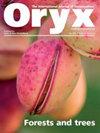Projecting forest cover in Madagascar's protected areas to 2050 and its implications for lemur conservation
IF 2.1
3区 环境科学与生态学
Q2 BIODIVERSITY CONSERVATION
引用次数: 0
Abstract
Abstract Predicting future conservation needs can help inform conservation management but is subject to uncertainty. We measured deforestation rates during 2015–2017 for 114 protected areas in Madagascar, linked deforestation to the status of protection according to IUCN categories I–VI, used recent deforestation rates to extrapolate forest cover over 2017–2050 and linked the size of forest blocks to the projected persistence of lemur subpopulations. In the six IUCN categories for protected areas in Madagascar the median size of forest blocks is 9–37 km 2 and median annual deforestation rates range from 0.02% in the single IUCN category III site to 0.19% in category II and 1.95% in category VI sites. In 2017, 40% of all forest blocks within protected areas were < 10 km 2 , and this is projected to increase to 45% in 2050. Apart from these small forest fragments, the modal site of forest blocks was 160–320 km 2 in 2017, and this is projected to decrease to 80–160 km 2 in 2050. The range of > 50% of all lemur species exclusively contains forest blocks of < 10 km 2 . The modal size of forest blocks > 10 km 2 is predicted to remain at 120 km 2 until 2050. Although uncertainty remains, these analyses provide hope that forest blocks within the protected areas of Madagascar will remain large enough to maintain lemur subpopulations for most species until 2050. This should allow sufficient time for the implementation of effective conservation measures.预测2050年马达加斯加保护区的森林覆盖率及其对狐猴保护的影响
预测未来的保护需求有助于为保护管理提供信息,但受到不确定性的影响。我们测量了2015-2017年马达加斯加114个保护区的森林砍伐率,将森林砍伐与国际自然保护联盟I-VI类保护状况联系起来,利用最近的森林砍伐率推断2017-2050年的森林覆盖率,并将森林块的大小与狐猴亚种群的预测持久性联系起来。在IUCN对马达加斯加保护区的六个分类中,森林块的中位数大小为9-37平方公里,年毁林率中位数范围从IUCN单一III类遗址的0.02%到II类遗址的0.19%和VI类遗址的1.95%。2017年,在保护区内的所有森林块中,有40%是森林块。10平方公里,预计到2050年将增加到45%。除了这些小森林碎片外,2017年森林块的模态面积为160-320 km2,预计到2050年将减少到80-160 km2。>在所有狐猴物种中,有50%只在森林中生长。10公里2。森林块的模态大小>预计到2050年将保持在120公里/ 2。尽管不确定性仍然存在,但这些分析提供了希望,马达加斯加保护区内的森林块将保持足够大,以维持大多数物种的狐猴亚种群,直到2050年。这样就有足够的时间实施有效的养护措施。
本文章由计算机程序翻译,如有差异,请以英文原文为准。
求助全文
约1分钟内获得全文
求助全文
来源期刊

Oryx
环境科学-生态学
CiteScore
5.30
自引率
7.40%
发文量
150
审稿时长
18-36 weeks
期刊介绍:
ORYX—THE INTERNATIONAL JOURNAL OF CONSERVATION, a quarterly journal from Fauna & Flora International, publishes research on biodiversity conservation, conservation policy and sustainable use, and the interactions of these matters with social, economic and political issues. The journal has a particular interest in material with the potential to improve conservation management and practice. Explore the map for details of published articles.
 求助内容:
求助内容: 应助结果提醒方式:
应助结果提醒方式:


